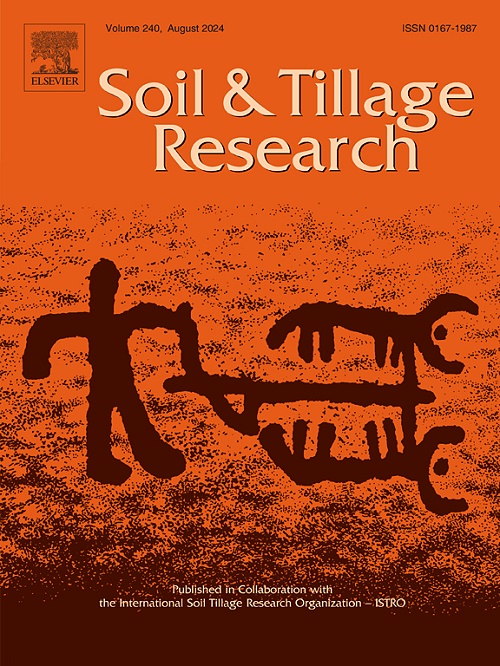Water-stable soil aggregation and associated carbon in a no-till Atwood silt loam soil with cover crops and poultry litter
IF 6.8
1区 农林科学
Q1 SOIL SCIENCE
引用次数: 0
Abstract
Knowledge on integrating cover crops and poultry litter effects on soil aggregation and associated carbon remains uncertain. In this study, aggregate size fractions, aggregate stability, and aggregate-associated carbon were examined within the topsoil (0–5 cm depth) across five winter cover crops [no cover crop as a control, cereal rye (Secale cereale L.), winter wheat (Triticum aestivum), hairy vetch (Vicia villosa), and mustard (Brassica rapa) plus cereal rye (mix)] and three fertilizer sources (no fertilizer as a control, recommended inorganic fertilizers, and poultry litter) in a split-plot design in no-till upland Atwood silt loam soil. Results demonstrated that the aggregate size 0.25–0.053 mm was the most dominant, containing the largest soil organic carbon (SOC) stock, and contributing significantly to the bulk SOC in no-till upland Atwood silt loam soil. Among the cover crops, the mustard plus cereal rye cover crop increased SOC stock both in bulk soil (10.0 Mg ha−1) and in the 0.25–0.053 mm aggregates (7.1 Mg ha−1). The corresponding increases for poultry litter were 9.7 and 5.9 Mg ha−1, respectively. The highest values for aggregate stability index, mean weight diameter, and geometric mean diameter (56.8 %, 1.0 mm, and 0.6 mm, respectively) were obtained under winter wheat cover crop, while fractal dimension and soil erodibility factor were highest (2.8 and 0.14, respectively) under no cover crop. Multivariate analysis revealed the > 2 mm aggregates was the most dominant predictor for the stability of soil aggregates, suggesting its pivotal role in affecting soil aggregate stability. Aggregate-associated carbon positively correlated with aggregate stability index. Overall, integrating cover crops such as winter wheat and mustard plus cereal rye, along with poultry litter, can increase the stability of soil aggregates and improve SOC stock, which may further enhance the sequestration potentials of soil carbon and decrease the threat of soil degradation and erosion in agricultural systems.
覆盖作物和家禽凋落物的免耕阿特伍德粉砂壤土水稳性土壤团聚体和伴生碳
关于综合覆盖作物和家禽凋落物对土壤团聚体和相关碳的影响的知识仍然不确定。在本研究中,研究了5种冬季覆盖作物(无覆盖作物为对照,谷物黑麦(Secale cereale L.),冬小麦(Triticum aestivum),毛豌豆(Vicia villosa)和芥菜(Brassica rapa)加谷物黑麦(混合))的表层土壤(0-5 cm深度)中团聚体粒度分数,团聚体稳定性和团聚体相关碳。在免耕的阿特伍德旱地粉壤土中采用分块设计。结果表明:免耕阿特伍德旱地粉砂壤土团聚体粒径0.25 ~ 0.053 mm占主导地位,土壤有机碳储量最大,对土壤有机碳总量贡献显著;在覆盖作物中,芥菜加谷物黑麦覆盖作物增加了块土(10.0 Mg ha−1)和0.25 ~ 0.053 mm团聚体(7.1 Mg ha−1)的有机碳储量。家禽产仔相应增加9.7和5.9 Mg ha−1。冬小麦覆盖下的土壤总体稳定性指数、平均重径和几何平均径最高,分别为56.8% %、1.0 mm和0.6 mm;无覆盖下的土壤分形维数和土壤可蚀性因子最高,分别为2.8和0.14。多因素分析显示,>; 2 mm团聚体是土壤团聚体稳定性的最主要预测因子,表明其在影响土壤团聚体稳定性中起关键作用。团聚体伴生碳与团聚体稳定性指数呈正相关。综上所述,冬小麦、芥菜、谷物黑麦等覆盖作物与家禽凋落物结合可提高土壤团聚体的稳定性,提高土壤有机碳储量,从而进一步增强土壤碳的固存潜力,降低农业系统土壤退化和侵蚀的威胁。
本文章由计算机程序翻译,如有差异,请以英文原文为准。
求助全文
约1分钟内获得全文
求助全文
来源期刊

Soil & Tillage Research
农林科学-土壤科学
CiteScore
13.00
自引率
6.20%
发文量
266
审稿时长
5 months
期刊介绍:
Soil & Tillage Research examines the physical, chemical and biological changes in the soil caused by tillage and field traffic. Manuscripts will be considered on aspects of soil science, physics, technology, mechanization and applied engineering for a sustainable balance among productivity, environmental quality and profitability. The following are examples of suitable topics within the scope of the journal of Soil and Tillage Research:
The agricultural and biosystems engineering associated with tillage (including no-tillage, reduced-tillage and direct drilling), irrigation and drainage, crops and crop rotations, fertilization, rehabilitation of mine spoils and processes used to modify soils. Soil change effects on establishment and yield of crops, growth of plants and roots, structure and erosion of soil, cycling of carbon and nutrients, greenhouse gas emissions, leaching, runoff and other processes that affect environmental quality. Characterization or modeling of tillage and field traffic responses, soil, climate, or topographic effects, soil deformation processes, tillage tools, traction devices, energy requirements, economics, surface and subsurface water quality effects, tillage effects on weed, pest and disease control, and their interactions.
 求助内容:
求助内容: 应助结果提醒方式:
应助结果提醒方式:


